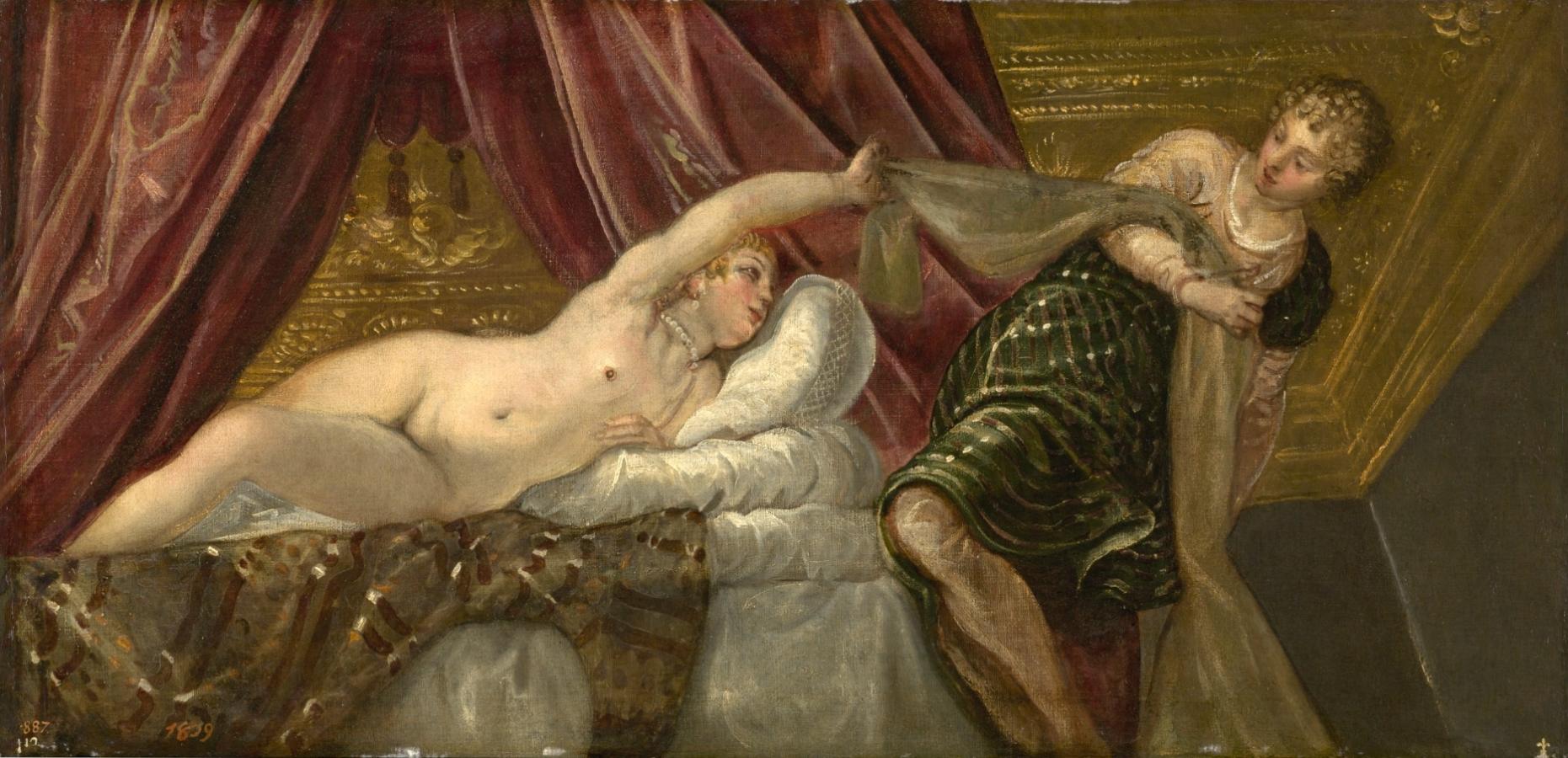Tintoretto, Jacopo (1518-1594)
Giuseppe e la moglie di Putifarre (Joseph and Potiphar’s Wife)
c.1555
Oil on canvas, 54 x 117 cm
Museo del Prado, Madrid
Joseph is a handsome and virtuous slave falsely accused of rape by his master’s wife, whose advances he has rejected. He is imprisoned, but eventually raised to the highest office by Pharaoh (Exodus: 39). Joseph and the Wife of Putiphar and Susannah and the Elders (P386) can be understood as parables of righteousness threatened and preserved, but here -as was usual for artists of the Renaissance and Baroque- they are presented in terms of sensuous appeal and erotic charge rather than as moral lessons. Potiphar´s wife, lushly nude except for her jewelry, appears extremely sexually aggressive. Grasping the cloth that exposes the body of Potiphar’s wife, Joseph’s backward motion only serves to exaggerate her advances. The two pictures were part of a decorative cycle that also includes representations, in a similar format, of four other Old Testament subjects: Esther before Ahasuerus (P388), Judith and Holofernes (P389), Solomon and the Queen of Sheba (P394), and the Finding of Moses (P396). The six pictures are united by a shared color scheme; an unusually long, rectangular format; and a rhythm of curving, undulating forms that runs from painting to painting. With their doll-like figures and emphasis on surface pattern, these works are far from typical of Jacopo Tintoretto‘s usual style, which is characterized by intense chiaroscuro and high drama, based on heroically idealized depictions of the human body in action. These pictures are in a very different mode, one that is related to their function as furniture painting, intended primarily as decoration. Their long, narrow format; oblique perspective; decorative approach; and multiple panels indicate that they were painted as a set to adorn the upper portion of a room. Nothing is known of the original commission or location, although the ensemble was clearly intended for a secular context. The biblical subject matter provides little more than an occasion for the depiction of exotic costumes, courtly ceremony, and naked flesh. The decorative appeal of the ensemble was not lost on Diego Velázquez, who acquired it for Philip IV (r.1621-65) on his second trip to Venice. Upon its arrival in Spain, the cycle was placed on a ceiling in the so-called Bóvedas de Tiziano (Titian Vaults) in the Alcazar Palace in Madrid, which housed the other nudes in the Spanish Royal Collections. Later, the paintings became part of the collection of Queen Isabel Farnese (r. 1714-46), second wife of Philip V (r. 1700-46), at the Royal Palace of La Granja de San Ildefonso, near Segovia. Tintoretto was not widely collected in Spain during his lifetime or in the decades that followed. While he obtained several important commissions from Philip II, his style seems not to have appealed to the royal tastes, and his efforts to take the place of Titian in the king’s favor after the older artist’s death were unsuccessful. Nor were his paintings widely collected by members of the Spanish nobility during this period. The situation changed dramatically in the middle third of the seventeenth century. These were the years in which Velázquez exerted his greatest influence on Spanish collecting, and, as Miguel Falomir has suggested, the change can be attributed primarily to the Spanish painter’s appreciation for his Venetian predecessor (Tintoretto, 159-162). By 1686, the number of paintings by Tintoretto hanging in the Alcázar Palace alone (forty-three) was exceeded only by those of Titian (seventy-six) and Rubens (sixty-two), and was equivalent to that of Velázquez himself (Text drawn from Echols, R.: Splendor, Myth, and Vision. Nudes from the Prado, 2016, pp. 78-79). (MNP)
